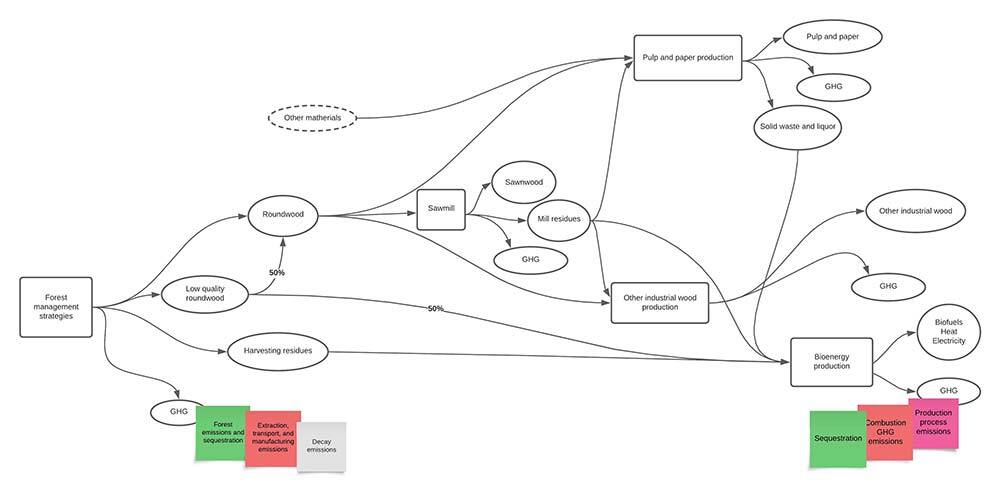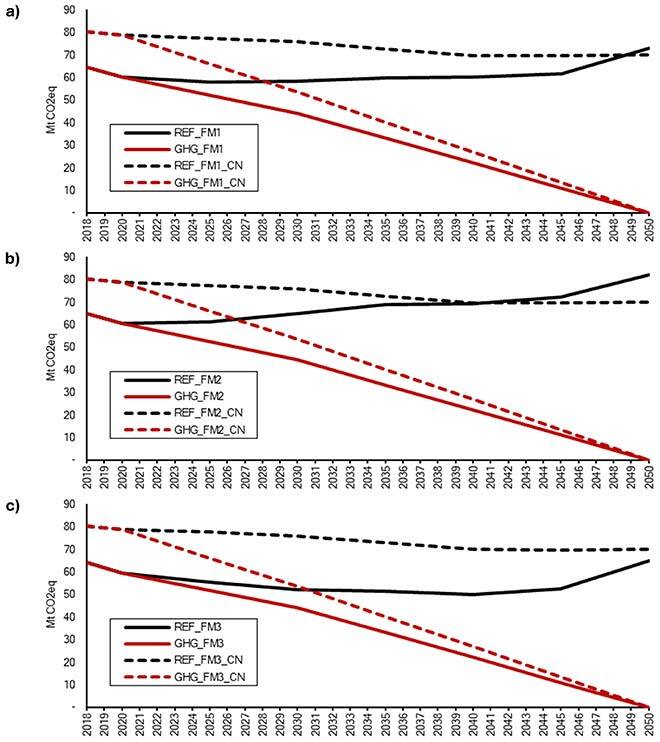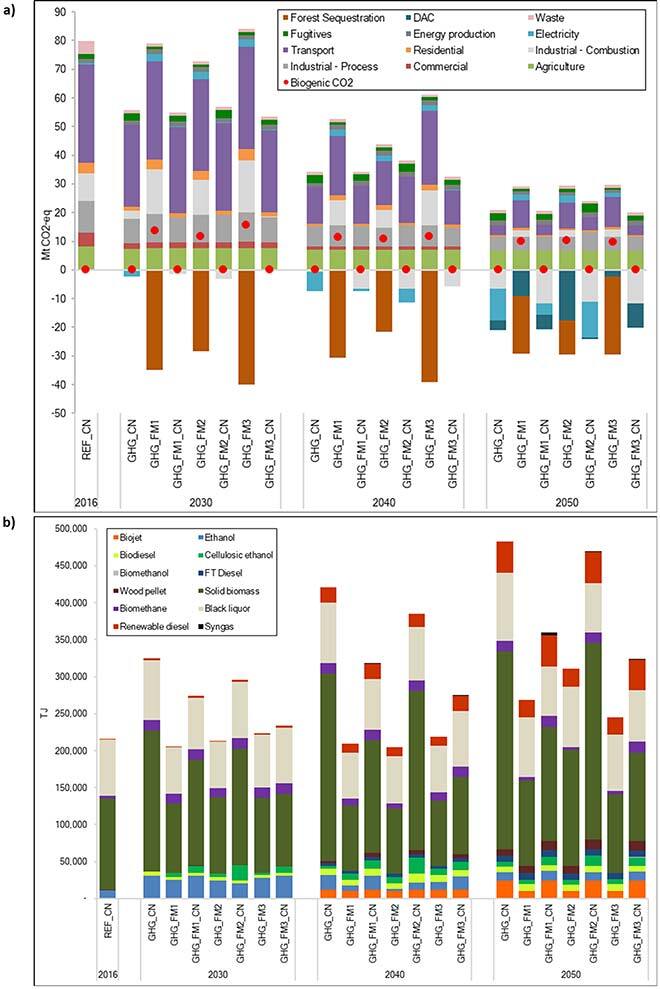
As the world strives to limit global warming to 1.5 °C, strategies for decreasing greenhouse gas emissions and removing carbon dioxide from the atmosphere are becoming crucial. Among these, forest bioenergy is often viewed as a carbon-neutral alternative to fossil fuels. But is this assumption truly accurate? Our study challenges this notion by integrating a forest carbon budget model with an energy system model to analyze the impact of biogenic carbon on decarbonization pathways in the province of Quebec. We found that incorporating forest carbon emissions and sequestration into energy planning significantly eases the challenge of decarbonization. Moreover, we discovered that effective forest management strategies can greatly reduce the reliance on costly negative emission technologies. This research underscores the importance of reevaluating our approach to bioenergy and forest management to make more informed decisions for a sustainable future.
Addressing climate change effectively requires us to significantly reduce carbon dioxide in the atmosphere. This can be achieved through various strategies, including expanding forests, managing existing forests more efficiently, enhancing soil carbon uptake in agriculture, and combining bioenergy production with carbon capture and storage (BECCS), all known as carbon dioxide removal (CDR) technologies. Most of these methods are currently feasible, affordable, and ready for a large-scale implementation. However, there are challenges, such as the competition in terms of demand for wood products and the potential saturation of carbon sinks in forests over time.
The concept of “biogenic carbon”—carbon in biomass like plants and trees—is crucial in these discussions. Typically, the carbon released when biomass is burned is balanced by the carbon absorbed during the plant’s growth, leading to the assumption of “carbon neutrality”. But this balance can vary, especially with long-lived plants like trees. Our research integrates models of forest carbon dynamics with energy system models to better understand how bioenergy and forest management can help mitigate climate change, specifically focusing on Quebec, Canada. This approach is novel, as it combines detailed forest carbon data with energy system modeling to explore the most effective strategies for reducing greenhouse gases by 2050.

Accordingly, we used the output of the Canadian Forest Sector Carbon Budget Model (CBM-CFS3) to model forest management approaches that could lead to different biomass availability for bioenergy and forest net emissions, in order to see if and how this biomass could be used within the energy system over the time horizon considered (Figure 1). Following that, we provided a detailed modeling of various forest-based bioenergy pathways with and without CCS. These pathways are implemented in a detailed bottom-up energy model for Quebec.
We explored three forest management strategies: FM1—business-as-usual; FM2—intensification with increased harvesting and reduced sequestration; and FM3—conservation with decreased harvesting and enhanced sequestration. Biomass distribution adheres to the forest product supply chain (Figure 2) meeting primary, secondary, and bioenergy industry needs. This approach integrates changes in forest management and reforestation as CDR strategies. Additionally, we incorporated BECCS by including 94 forest-based bioenergy technologies, both with and without CCS. For an overview of our energy system model, please refer to Figure 1 in our previous article in Substance (Kouchaki-Penchah and Levasseur, 2022).

In our study, we explored different future possibilities, or “scenarios,” to see how changing the way we manage forests and use forest resources could impact our energy model. The “REF_CN” scenario represents one situation: continuing existing practices without new measures to manage forests, capture carbon, or reduce emissions. In contrast, “GHG_CN” is an ambitious scenario aiming to significantly reduce greenhouse gas emissions by 2030 and achieve net-zero emissions by 2050. Other variations on these scenarios introduce different intensities of forest management (identified with FM1, FM2, and FM3), with some scenarios treating the forests’ carbon dioxide absorption and release as a neutral factor (identified with “CN”), and others taking this biogenic carbon into account.
Managing Forests to Steer Our Greenhouse Gas Future
Incorporating forest carbon emissions and sequestration into our models reveals its significant impact on decarbonization efforts. For instance, by 2040, total GHG emissions under the REF_FM1 scenario show 60 Mt CO2-eq, compared to nearly 70 Mt in its carbon-neutral variant, REF_FM1_CN (Figure 3 (a)). This finding emphasizes the potential of forest management in moderating GHG trajectories, rather than delaying decarbonization efforts. Interestingly, after 2040, REF_FM2, an intensification strategy, shows higher emissions than REF_FM2_CN due to the limited offsetting capability of forest sequestration against biogenic CO2 emissions (Figure 3 (b)). This trend is also observed in other management scenarios like FM1 and FM3, albeit at different times, highlighting their varying sequestration capacities. Notably, REF_FM3, which focuses on conservation, demonstrates the lowest GHG emissions by 2050 among all scenarios, suggesting that selecting the right forest management strategy can significantly reduce the pressure on the energy system to achieve net-zero emissions by 2050 (Figure 3 (c)).

The Assumption of Carbon Neutrality Can Lead to Biased Decision-Making
Our findings highlight the risks of assuming biogenic carbon neutrality. Post-2030, scenarios based on this assumption (GHG_CN, GHG_FM1_CN, GHG_FM2_CN) overly rely on capturing and sequestering CO2 from biomass consumption through BECCS, which is seen as a negative amount in GHG calculations (Figure 4 (a)). Achieving net-zero emissions by 2050 requires the use of DAC, with its extent dependent on forest sequestration capacity. In 2050, the GHG_FM2_CN scenario shows less reliance on DAC (<1 Mt CO2-eq), but this doesn’t equate to FM2 being the most efficient in reducing DAC. Including biogenic emissions (GHG_FM2) actually increases DAC needs (18 Mt CO2-eq). This demonstrates the potential for biased decision-making when neglecting biogenic CO2 emissions. Among the scenarios that incorporate biogenic CO2, GHG_FM3 shows the least dependency on DAC (2 Mt CO2-eq), attributed to enhanced forest carbon sequestration. This positions the FM3 strategy as a potentially optimal approach for achieving net-zero emissions by 2050, especially considering the current practical challenges and scaling limitations faced by DAC technology (Figure 4 (a)).

The key difference between scenarios with and without the assumption of carbon neutrality lies in the higher short-term emissions when biogenic carbon is included. By 2050 (Figure 4(b)), this results in a 25%, 34%, and 24% reduction in bioenergy use in GHG scenarios FM1, FM2, and FM3, respectively. Assuming carbon neutrality allows for greater biomass or bioenergy use without the constraints of biogenic CO2 emissions, but this can lead to skewed decision-making due to insufficient future sequestration. This assumption notably affects choices in BECCS and bioenergy sources. For instance, syngas production via gasification is only viable under carbon neutrality, with the amount produced varying based on the forest management strategy. Hence, identifying the most effective forest management strategy is crucial before investing in BECCS.
Conclusions
Incorporating forest sequestration into decarbonization strategies can moderate GHG trajectories, especially in hard-to-decarbonize sectors. Including biogenic CO2 emissions in nationally determined contributions (NDCs) is crucial, as their exclusion can skew mitigation outcomes and impact the choice of BECCS alternatives. Optimal forest management strategies must be identified before heavily investing in BECCS, considering the varying biomass utilization methods based on availability and sequestration capacity. Ignoring biogenic emissions in models could lead to biased decision-making by overestimating biomass usage. While immediate investments in BECCS and other NETs might be challenging, transitioning to cost-effective forest management strategies is vital for meeting the 2 °C warming limit post-2030 and achieving net-zero emissions by 2050. More ambitious emission reduction targets are feasible before 2030, and full integration of the forest sector into energy models like NATEM is recommended for effective planning and to enhance the models’ accuracy in addressing climate change.
Additional Information
- For further insight, please refer to the following papers:
- Kouchaki-Penchah, H., Bahn, O., Vaillancourt, K., Moreau, L., Thiffault, E., Levasseur, A., 2023. “Impact of Biogenic Carbon Neutrality Assumption for Achieving a Net-Zero Emission Target: Insights from a Techno-Economic Analysis,” published in Environmental Science & Technology, Volume 57, Pages 10615–10628. Available at: https://doi.org/10.1021/acs.est.3c00644.
- Our previous article: Kouchaki-Penchah, H., Levasseur, A., 2022. “Achieving Decarbonization Using Forest-Based Bioenergy,” published in Substance: Scientific News and Innovation, ÉTS. Available at: https://www.etsmtl.ca/en/news/achieving-decarbonization-using-forest-based-bioenergy.
- Additionally, we recommend reviewing our paper that explores the role of hydrogen in a net-zero emission economy, incorporating the dynamics of biogenic CO2 flows: Kouchaki-Penchah, H., Bahn, O., Bashiri, H., Bedard, S., Bernier, E., Elliot, T., Hammache, A., Vaillancourt, K., Levasseur, A., 2023. “The Role of Hydrogen in a Net-Zero Emission Economy Under Alternative Policy Scenarios,” featured in the International Journal of Hydrogen Energy. Available at: https://doi.org/10.1016/j.ijhydene.2023.07.196.



